Paid Workshops & FREE Events
May 22nd Market Direction
Last Wednesday’s big selloff showed a dramatic change of investor sentiment with a Doji followed by a gap down and a close well below the T-line. This would have indicated the probabilities of more bearish sentiment. However the following day, the indexes started showing bullish reversal signals. The NASDAQ created a piercing signal. This at least provided the prospects of knowing which way the market was moving based upon how the trading opened after the buy signals. As seen, the NASDAQ is formed a bullish Doji sandwich bringing the trading backup above the T-line and above the open of the big bearish candle of Wednesday. This produces a new and obvious candlestick scenario. The J-hook pattern of the markets reveal the possibility once again of a another wave to the upside, a J-hook pattern wave three. The probabilities of the uptrend remaining in progress is very simple to assess. As long as the indexes continue to trade above the T-line, it has to be assumed the uptrend remains in progress.
Another valuable piece of information that can be illustrated in candlestick charts is a simple visual analysis of relative strength. Our purchase of the June 10 calls in BBRY at $.34 last week was held through the big selling day of Wednesday because of the lack of any selling indication in the chart. This is not rocket science. Observing that there was indecisive selling and no real pullback provided the visual evidence that there was still going to be continued strength in BBRY. Continuing to hold that position was also reinforced by the fact that there was no candlestick sell signal and no close below the T-line. Whereas other chart patterns showed closes below the T-line, the correct trade program was to close those positions out but be ready to buy back if they came back up above the T line. This simple visual technique allows investors to continue to hold strong bullish positions when the market is absolutely going in the wrong direction and closing out positions that demonstrate sell signals. When new strength comes into the markets, stock charts such as BBRY will usually have continued strength, currently moving the June 10 calls from $.34 up to $1.52. The visual analysis of candlestick charts provide an immense amount of information that can greatly reduce the emotions involved in investing.
We will conduct a “Members Only” chat session tonight at 8:00 p.m EST.
Good Investing,
The Candlestick Forum Team
Website special reflects current newsletter. If you are reading an archived newsletter you will be directed to the Current Website Special
Trading Breakout
A trading breakout is an upward movement of the price in trading stocks, trading options, trading commodities, or trading futures that occurs after a period of the equity in question trading within a range. Traders can profit by trading the support and resistance zones of the trading range and they profit from anticipating and effectively trading the trading breakout. Traders use two methods to anticipate a trading breakout. One is the tool of long term investing. It is fundamental analysis.
The trader may come to believe, after taking a close look at a stock’s fundamentals, that its intrinsic stock value is greater than the stock price range it is trading in. Thus he will anticipate an upward trading breakout based strictly upon fundamentals. The more effective way to anticipate and profit from a trading breakout is to combine both fundamental and technical analysis of the stock in question. Using Candlestick pattern formations as a guide, a trader can commonly let the market tell him what it will do. Using price patterns the trader can successfully anticipate when a trading breakout will occur. Although the fundamentals may indicate an eventual upward movement in stock price it is technical analysis with Candlestick charts that tells the trader when to make the move.
Stocks and other equities trade in ranges based upon the market’s consensus of price. The upper and lower limits of the trading range are often set by the market’s reading of the stock’s fundamentals. Traders will buy in the belief that the stock will go up in price and sell in the belief that it will go down in price. Lots of traders buying a stock drive the stock price up and lots of traders selling a stock drive the stock price down. Using Candlestick analysis the wise trader will typically be able to anticipate price turnarounds at both the high and low ends of the stockfs trading range.
A stock that is trading between its support and resistance prices is not a stock on an upward or downward trend. It is often a stock about which the market has not made up its collective mind. When the market starts to come to a consensus on a stock, the stockfs trading range may start to narrow. This is one of the signals that a stock may be ready for a trading breakout. By the use of Candlestick stock charts a trader can commonly see the trading breakout coming as predicted by Candlestick patterns that evolve as the stock price progresses.
After a trading breakout a stock may well follow current market trends, in a bull market, for example. Looking at the broader market will help the trader anticipate market reversal, continuance of the trend, or even a market rally. Following the stock with Candlestick signals will help the trader decide when to sell stock or when to sell short in anticipate of a substantial decline in stock price. Depending on the intrinsic stock value and margin of safety of a stock the profits from a trading breakout may well be long term and not temporary. Letting Candlestick signals be a guide the wise trader can often multiply profits from an upward movement in a stock’s price.
This past week the market produced some confusing information. The Dow continued its uptrend. It had formed a couple of Doji’s but they were not confirmed. The NASDAQ showed hard selling but it did not create a true candlestick sell signal. As the Dow was continuing upward, the NASDAQ was moving down. Although this is not normally an uncommon occurrence, the magnitude in which each index was moving revealed buying and selling that did not correlate with each other. Today’s strengths continued the DOW trend while forming a bullish Harami in the NASDAQ. This continues to reveal the importance for knowing which signals and price movements are real candlestick signals.
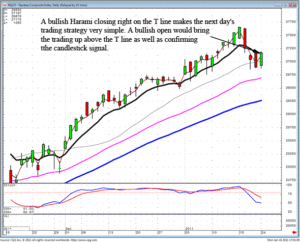
DOW
As illustrated in the NASDAQ, the lack of a reversal signal should have given more evidence to a temporary pullback versus a full-fledged reversal. The reversal of a trend is still likely to be dictated by a recognized candlestick sell signal. Today’s positive trading was confirmation that a lack of a sell signal meant the Bulls were still in control.
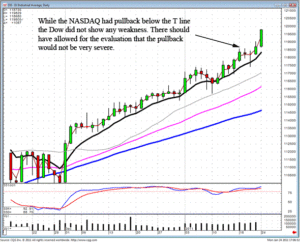
NASDAQ
There will often be times in the market when it is difficult to analyze which direction the trend is going. Fortunately, with candlestick analysis, indicators for whether to be long or short will fall back into place. The Dow and the S&P 500 both closed above the T-line. The Dow had not even made the T-line a contention. The S&P 500 showed indecisive trading at the T-line and then traded back above it. The NYSE, a much broader index than the Dow 30, also showed a chart pattern that supported at the T-line. The NASDAQ is the only major index that was trading below the T-line. It formed a bullish Harami today. This makes the trend analysis come back together. A positive open tomorrow in the NASDAQ would confirm the Bulls were still in control in all indexes.
The commonsense aspects of investing are built into candlestick analysis. Whether a day trader, swing trader, or long-term investor, being able to analyze the overall trend of the market is an extremely important aspect for establishing positions. Most investors never find the proper trading platform. They are expecting the green arrow and the red arrow to indicate when it is time to buy and when it is time to sell. The candlestick investor gains a huge advantage by understanding what the overall market trend is doing and then analyzing with stocks will perform the best. This also allows for flexibility in market conditions that other investors may have a difficult time maneuvering. Currently, there are stocks that are performing well to the long side as well as stocks performing well to the short side. When market conditions become fuzzy, the candlestick investor still has the capability of analyzing individual stock patterns that will work well whether the market is going up or going down. Essentially this is the investment knowledge that will allow you to control your returns no matter which direction the market is going.
Chat session tonight at 8 PM ET
Good Investing,
The Candlestick Forum Team
Website special reflects current newsletter. If you are reading an archived newsletter you will be directed to Current Website Special
Swing Trading Stocks – Big Profits With Candlestick Signals
Swing trading stocks has become more prevalent over the past few years. The instant trading capabilities provided by online trading services has made swing trading stocks a highly profitable trading program. Candlestick signals increase the profitability for swing trading stocks. The recent volatility, or lack of volatility, in the markets has made swing trading stock programs a much more viable profit producer for short term investors.
Candlestick signals are the measure of investor sentiment during a certain time frame. This time frame could be a one-minute chart pattern or a monthly chart pattern. Whereas the day trader may use one-minute, five-minute, and fifteen- minute chart combinations, the investor that is swing trading stocks may be more inclined to use daily charts only. Normally swing trades last anywhere from two to ten trading days. The long-term investor, on the other hand, would use a daily, weekly, and monthly chart combination to best evaluate their positions. Utilizing candlestick charts makes this evaluation much easier
Using a daily chart for swing trading stocks can utilize Candlestick signals very profitably. When markets do not appear to have any directional force for more than a few days at any time, swing trading stocks becomes the most viable program. The normal reversal action usually involves a three day pattern. Building this into a choppy market scenario produces some high-profit trades.
Market Direction
Last week the Dow went through a very choppy period. Monday’s big day to the upside indicated a Double Bottom. It formed a Bullish Engulfing signal while stochastics were still moving in an upward direction. This strong up-move provided valuable information coming out of the congestion area. This made the next logical target the 50 day and 200 day moving averages. The pullback on Wednesday was not an unexpected event after the 170 point move in the Dow.
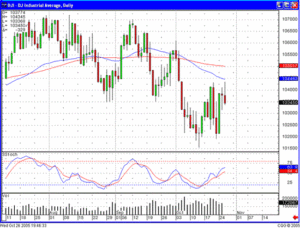
Dow
The NASDAQ just touched the 50 day moving average on Wednesday. With the Dow needing a couple of more days to get out into the moving average area, and the NASDAQ forming a Shooting Star signal indicates that the uptrend may be running out of steam. It is doing so at obvious descending trend lines that have formed through the recent tops. Another failure at those trend lines would indicate that it was time to take some profits and start watching for the down-trending markets to start again.
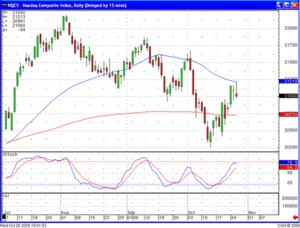
NASDAQ
Breakouts
Breakouts are the most powerful patterns. The initial breakout candle usually becomes an alert to investigate what has changed investor sentiment regarding that stock. A large candle, coming out of a stagnant trading range, is usually instigated by news or an event that is going to greatly affect the future of that company. The AVII chart illustrates a big candle formation accompanied with large volume. There was good news for the company that day. An important factor for profiting from a breakout situation is to be able to identify what investors are doing after a big percentage move. Severe selling conveys a much different message than profit-taking candles.
As seen in the AVII chart, the sellers did not have enough force to drive the price back down after the initial breakout. That has led to another big percentage move in the price of the stock over the next few weeks. A high probability scenario, after the initial breakout, will be that the price trend will continue up for a good amount of time. Whatever news that caused the breakout will continually be analyzed through the different investment medias.
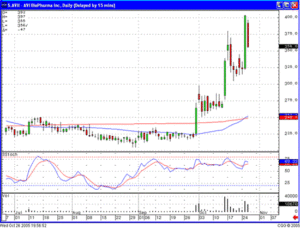
AVII
The same scenario is illustrated in the Electro Energy Inc. chart. News about a contract on their lithium batteries has now brought attention to the stock. The initial profit-taking after an approximately 45% positive day appears to be over. The anticipation of further upside movement is based on the prospects that more people will invest in the company as the news about their contract is disseminated to the print media. The advantage that Candlestick signals provide is being able to identify what investors are doing after the initial breakout move. The next two days were Hammer-type signals, indicating some profit-taking but no severe selling. Once that selling was soaked up, the buying continued.
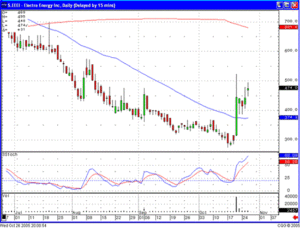
Electro Energy
The Book is Finished!
‘High Profit Candlestick Patterns’ is at the printers. The expected delivery date is near the end of November or the beginning of December. This book will contain over 400 pages of Candlestick insights. It will go into much more detail on the major signals, entry and exit strategies, and stop loss procedures. Bill Johnson, who has written a number of books on option trading strategies, has added a chapter on how to improve your Candlestick option trading programs. Tina Logan, a well-known technical trading strategist has contributed a chapter on her insights for utilizing Candlestick signals in short term technical trading.
Revealed in:
High Profit Candlestick Patterns:
Turning Investor Sentiment into Profits
by Stephen W. Bigalow
The immense amount of information incorporated into Candlestick signals is abundantly illustrated with simple visual techniques. The often misunderstood Japanese Candlestick charting techniques are clearly demonstrated. Steve Bigalow’s ‘Profitable Candlestick Trading’ book resulted in an overwhelming response from investors finally learning how to utilize Candlestick signals profitably. His new book ‘High Profit Candlestick Patterns’ introduces the investor to a refreshingly new and high-powered investment perspective. Candlestick signals provide visually compelling results. Japanese Candlestick charting techniques, integrated with statistically proven Western technical analysis, produce an even more powerful investment platform. The ability to recognize trading patterns in their very early stages empowers an investor with high profit trading strategies.
For the technical investor, the combined analysis provides potent trading programs. The fundamental investor gains tremendous insights into the timing of positions. The introduction of cutting-edge computer generated technical analysis, with the world’s most proven trading technique, becomes a powerful tool for understanding the movements of the markets. Discover simple techniques that put the probabilities highly in your favor.
The book is scheduled to be published in the first week of December 2005. First edition, signed copies will be provided in pre-publication specials starting on November 1, 2005. Start watching for the promotions on the web site.
Be Prepared!
November should be a very busy month at the Candlestick Forum. The new site should be up and running. It will be much easier to maneuver to the services available for the members. A book special will be made available. Scheduling for another private training session will take place. And finally, funds will start to be accepted for the Candlestick Partner Hedge Fund. Watch for the announcements.
Private Training Sessions
The analysis of what one market can do to another is easily evaluated when using Candlestick signals. The process for projecting market direction becomes relatively easy when a Candlestick investor can utilize the signals to evaluate all the markets that might be affecting the stock market. The better one can analyze the market direction, the much greater the profit potential.
Steve Bigalow spends a good amount of time during his two-day private training sessions demonstrating how to use the Candlestick signals to accurately evaluate market trends. Adding this information to the identification of high profit signal patterns allows an investor to control the profitability of their portfolio for the rest of their investment career.
Don’t miss the opportunity to gain some valuable knowledge first hand. The Candlestick signals produce an immense amount of analytical information. Whether trading stocks, commodities, Forex, or tulip bulbs, Candlestick analysis will dramatically improve your profitability. This information is taught in a very easy-to-understand manner.
If you’re interested in spending two full days with Steve Bigalow, learning all the intricacies for trading Candlestick signals profitably, do not miss this opportunity. The information that you are receive from a two-day training session with six months of follow-up will pay for itself many thousands of times over. You’ll get a full grasp of what makes prices move at reversal points. You’ll have a full understanding of the investor sentiment that make prices move. This knowledge will greatly enhance your profitability for the rest of your life.
We are in the process of scheduling more private training sessions for the coming months. We will provide the details in future newsletters.
If you would like more information on the training sessions, please contact us immediately. We will provide you with all the information you require for attending the next class. To contact us by phone, please dial our toll free number: 1-866-251-4015. Contact us now, spaces will fill up fast.
Monday Night ‘Members Only’ Chat Session
We will not have a chat session on Monday, October 31st due to Halloween. The next chat session for Members will be on Monday night, November 7th, at 8:00 p.m. Eastern time. Members, have a happy and safe Halloween weekend and we’ll see you on November 7th.
Thursday Night Open Chat Session
Everyone is invited to attend our Thursday night chat sessions. Please tell all of your friends! The next Open Stock Chat will be scheduled for Thursday night, October 27th, at 8:00 p.m. Eastern time.
The Major Signals Educational Package – NOW ON DVD!
The response to the 12 major signals CD training program has been astounding. There has been strong feedback that the in-depth analysis of each major signal is done in a clear and concise manner. The learning process becomes very easy when all the elements of what makes for a strong successful reversal signal to work correctly is explained by Stephen W. Bigalow. Each 45-minute training session not only explains what indicators confirm the effectiveness of each of the major signals, but it goes into the investor psychology that was present that made each signal occur. Understanding the psychology of investors when a reversal is occurring is a tremendous insight into what makes prices move.
A New Twist to an Old Favorite!
DVDs of the 12 Major Candlestick Signals – For those of you that would like to thoroughly analyze the 12 major signals, the signals that will perform more reversal patterns prospects than most investors will be able to utilize, the eight hours of concise analysis for each signal is now on DVD’s. For the investor who likes to get comfortable in front of their TV screen, this DVD set will provide the opportunity to relax and learn at the same time.
Over $509 of valuable Candlestick signal education, for identifying the most powerful Candlestick reversal signals, is now priced at: $397.77
Do not delay, gain the understanding of how prices move. This is information that you will be able to use for the rest of your life. The profits that this information provides can be made in your account month after month after month.
You should never be put in a position where you do not understand why trades are being made for your account. Whether those positions are being put on in your managed account, or a hedge fund, or your own personal trading, you should have a full understanding of whether those funds are being put in the right positions at the right time. The Candlestick signals applied with Candlestick analysis will become the education process for understanding how to maximize your potential returns in your own trading or being able to analyze whether a money manager has any concept of correctly timing the markets.
Stock Investing Forum, Exchanging Candlestick Signal Ideas
The Candlestick Forum’s stock investing forum is getting good activity once again. The purpose of this stock investing forum is for investors, that are trying to gain more knowledge about candlestick signals, to ask questions and exchange observations that will help others gain the mastery of the signals. The stock investing forum is not limited to stocks. The exchange of ideas about using candlestick signals for Forex trading is also getting a lot of activity on the forum. This is a free service. Use it for asking general and specific questions about what signals are working in this market.
The forum can also be used as a running commentary on specific stock positions. As the price is moving, a running analysis on the progress of that trend can be easier to follow in a forum. A stock investing forum allows investors to hear what others are analyzing. An analysis of candlestick charts can be done with everybody’s import.
The Harami was an important signal this week. It signaled that the Nasdaq had stopped it’s downtrend. As the excerpt from “ Profitable Candlestick Trading” illustrates, the Harami is a major candlestick signal.
HARAMI
(Bullish Harami)

Description
The Harami is an often seen formation. The pattern is composed of a two candle formation in a down-trending market. The body of the first candle is the same color as the current trend. The first body of the pattern is a long body, the second body is smaller. The open and the close occur inside the open and the close of the previous day. Its presence indicates that the trend is over.
The Japanese definition for Harami is pregnant woman or body within. The first candle is black, a continuation of the existing trend. The second candle, the little belly sticking out, is usually white, but that is not always the case (See Homing Pigeon). The location and size of the second candle will influence the magnitude of the reversal.
Criteria
- The body of the first candle is black; the body of the second candle is white.
- The downtrend has been evident for a good period. A long black candle occurs at the end of the trend.
- The second day opens higher than the close of the previous day and closes lower than the open of the prior day.
- Unlike the Western “Inside Day”, just the body needs to remain in the
previous day’s body, where as the “Inside Day” requires both the body and the shadows to remain inside the previous day’s body. - For a reversal signal, further confirmation is required to indicate that the trend is now moving up.
Signal Enhancements
- The longer the black candle and the white candle, the more forceful the reversal.
- The higher the white candle closes up on the black candle, the more convincing that a reversal has occurred despite the size of the white candle.
Pattern Psychology
After a strong down-trend has been in effect and after a selling day, the bulls open the price a higher than the previous close. The short’s get concerned and start covering. The price finishes higher for the day. This is enough support to have the short sellers take notice that the trend has been violated. A strong day after that would convince everybody that the trend was reversing. Usually the volume is above the recent norm due to the unwinding of short positions.
Interactive Stock Training Class
One of the most effective means for traders to learn how to profitably buy stock and sell stock is through an interactive stock training class. Although there are many ways for someone beginning investing in the stock market to get basic stock market training an interactive stock training class allows for the give and take that is so important in learning how to trade stocks or trade options on stocks. Learning the 12 basic Candlestick analysis signals for effective technical stock trading will take some time reading and practicing in simulation. However, it will typically be in an interactive stock training class where it will all come together so that the trader can move to the next level of performance and profits in trading stock or in long term investing.
In setting up to trade stocks online a trader will need to purchase online trading software that is sufficient for his trading needs and compatible with that of the stock broker through whom he is going to trade stock. He will also need to purchase the computer hardware and internet connections with sufficient band width sufficient for the amount of data that passes during online trading. When the trader has these assets in place he will practice technical analysis of stocks in simulation mode in order to perfect his skills. It is during this time, especially, that the trader will benefit from the sound advice of an experienced trader available during an interactive stock training class. Upgrading skills in reading Candlestick patterns may be easier with an interactive stock training class such as Candlestick Forum Boot Camp where the open discussion may help clarify how to execute trades using Candlestick trading tactics.
Because options trading requires the same fundamental and technical analysis skills as stock trading, learning Candlestick pattern formations are just as important for options as for trading stocks directly. To profit from buying calls, selling calls, buying puts, or selling puts the trader will benefit from learning Candlestick charting techniques which will be clearer and easier to learn with the addition of an interactive stock training class to a new trader’s training regime.
A large part, some say the largest part, of successful trading and investing is maintaining the discipline to avoid letting the psychology of investing and the psychology of trading take over. Here is another reason to learn from give and take with a professional trader with years of experience. Trading is a business and a strong trading strategy is necessary in order to maintain profitable trading over time. As much as a trader may be skilled at technical trading as well as the stock fundamental analysis is often the ability to keep an even psychological keel that leads to long term success in trading. The association with traders with years of experience and the ability to ask precise questions and get precise answers can mean the difference between long term success and so-so results in trading. An interactive training class can provide this association with a trader with years of experience. Such a class can make the difference between a successful life trading stocks and a brief as well as unprofitable experience.
The candlestick investor has a great advantage when analyzing a potential reversal. Recently the Dow has demonstrated a few sell signals. Stochastics are in the overbought condition. However, the Dow could not close below the T-line. This remaining factor provided a simple scenario. The uptrend had to be considered to still be in progress until there was a close below the tee line. Today illustrated the bears were starting to take control. Both the Dow and the NASDAQ closed below the T-line. The NASDAQ provided an easier assessment of what was occurring in investor sentiment. It gapped down to the T-line but could not hold that level. What did that indicate? Any long positions that were starting to show weakness or confirming a sell signal should be closed out. The close below the T-line was the signal demonstrating which direction the market will move after four or five days of indecisive trading.
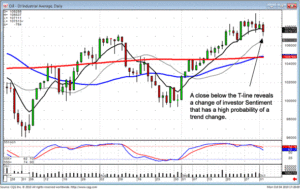
DOW
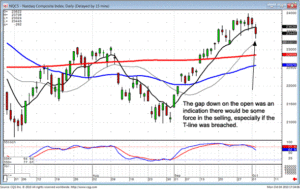
NASDAQ
The weakness in today’s market still makes a strong case for pattern setups. As illustrated in the recent recommendation of TSTC, the J-hook pattern setup was not affected by the selloff in today’s market. This provides another advantage for the candlestick investor. A pattern still has a high probability of producing a profit in spite of the overall direction of the market. The worst-case scenario will be that the price does not selloff as quickly as other stock prices when the market has reversed.
The strength of a price move is based upon the strength of the investor sentiment. This is what candlestick signals and patterns reveal. It allows for the participation in strong price moves and in price moves that do not selloff as quickly during a market reversal. This becomes a very important issue when trading stocks, but more important when trading options. Often trades can reverse fast, moving the prices of options very quickly. The longer a stock price maintains it strength in a weak market, the more opportunity there will be to close out an option trade at a reasonable price.
The TSTC chart illustrates the continuation of a pattern, the J-hook pattern, even though the market in general was showing weakness. This position will provide ample time to close out the position if weakness starts appearing because of the general market conditions.
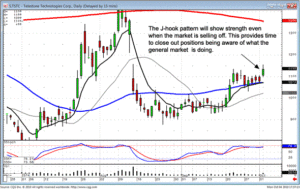
TSTC
Chat session tonight at 8 PM ET
Good Investing,
The Candlestick Forum Team
E-Learning Online Training Schedule
Website special reflects current newsletter. If you are reading an archived newsletter you will be directed to Current Website Special.
Stock Market Report – Rolling With The Changes
A stock market report is a summary of the most recent news of stock market sectors, stock groupings such as the Dow Jones Industrial Average, the Standard and Poor’s 500, the NASDAQ average, and outstanding stock movements either up or down. Reading at least the daily stock market report is important to keep a sense of perspective on where the stock market is and where stocks are going. However, investors and traders commonly invest or trade stocks one at a time and, thus, need to follow their individual stocks and market news that relates to specific market sectors. Investors and traders who buy stock or trade stock by way of index funds such as a fund that tracks the S&P 500 can get their stock market news more directly from stock market reports.
Wall Street news has been available in print by the Wall Street Journal since July 8, 1889 and before that in many newspapers ever since the markets opened. Up to minute market reports used to require a ticker tape machine that delivered stock prices by telegraph and printed an “endless” tape. In today’s electronic world updated reports and online stock investing newsletters are available from many sources. The scrolling stock prices at the bottom of the screen are the last vestige of the ticker tape machine. Up to date news allows investors to follow the latest stock market trends in the USA and in stock markets throughout the world . Up to date information is essential for the day trader who capitalizes on market inefficiencies during periods of high trading volume and high market volatility. Efficient market analysis requires the most recent market information.
To a degree, up to the minute stock market reports reduce the problem of insider trading in that information is generally available to everyone who is paying attention at the same time. Of course true insider trading deals where someone knows of a situation before it becomes public are still difficult, but not impossible, to predict. However, comprehensive stock market reports include lists of insiders who buy stock or sell stock of the company. These purchases or sales of stock shares are reported in Securities and Exchange Commission (SEC) filings. The definition of insider is a company’s officer, director and any “beneficial owner” of more than ten percent of a class of the company’s equity securities. A smart stock market trading strategy is to follow what the directors and owners of large blocks of stock are doing in a company where a investor wants to buy stock or a stock option.
Market reports are not just for checking minute by minute stock information. Much of the material in a good report is market analysis for long term investing purposes. Successful investing comes from a well thought out and executed investment strategy. Such a strategy requires analysis of stock market charts, company plans, the price to earnings ratio of a prospective investment, and more. This is the homework of investing and it requires taking the time to read and study all available information.
Market Direction
The hard sell off now has investor sentiment in an indecisive state. What do the candlestick signals indicate? The stochastics show the markets are getting to the oversold area, with another day or two before they get into the oversold condition. This allows the candlestick investor to plan for the next market move. Are the markets going to bounce from these levels? And to where? The downtrend was confirmed when it broke down through the 50 day moving average. A bounce should move the indexes back up to test the 50 Moving average.
Today’s trading showed some bullish strength, however there is nothing yet to alter the negative sentiment. Although the markets formed bullish Harami’s today, the stochastics are not yet in the fully oversold area. Any buying has to be done with great nimbleness. These are market conditions that making sitting on the sidelines for feasible for the next few days until a trend can be identified.
The patterns are still working effectively despite the strong pullback. PVTB has formed a strong Fry Pan bottom that has countered acted the selling of the past few days. Remember, the patterns are created by a build up of investor sentiment that usually does not become effected by the general market trend. This type of information allows investors to pinpoint where bulish moves are likely to occur when the general market environment is solidly negative.
( Please pardon the lack of charts. Still working on get Houston Computer system up and running)
Winter Training schedule
Feb 6 and 7 – Two day online training – If you are becoming familiar with the common sense aspects of candlesticks, take advantage of the 2-day online candlestick training. When you see the signals and patterns in a logical chronological order, your investment perspective will improve dramatically. This training program is assembled for easy and complete comprehension of where the signals work effectively and why the signals work effectively. You will gain powerful insights as to why prices move when they do. Your perception of how to enter and exit trades will change completely. You will learn how to set stop losses for taking small losses and maintaining strong gains. Once you obtain the enormous amount of information found in Candlestick Analysis, the Monday and Thursday night chat sessions become reinforcement to your learning process.
Option training, Option followup, commodity trading and Boot camp schedule will be announced this week.
Chat session tonight at 8 PM ET.
Good investing,
The Candlestick Forum Team
12 Major Candlestick Signals Educational Package!
Website special reflects current newsletter. If you are reading an archived newsletter you will be directed to the Current Website Special.
Picking Depressed Stocks
A falling tide lowers all ships, or in the case of the stock market, all stocks. But, do all stocks deserve to take a beating in a bad market? Picking depressed stocks in today volatile market can lead to stock trading and stock investing profits. Fundamental analysis and technical analysis both come into play when picking depressed stocks. Everyone wants to buy low and sell high but some stocks deserve to fall in price and will not recover. Picking stocks simply based upon a low price can be a recipe for failure. The point of picking depressed stocks to trade or invest in is that depressed stocks may well go up in price. The key to profits in picking depressed stocks is first to pick the right stocks and second to trade intelligently with tools such as Candlestick charting techniques.
Traders use technical analysis tools such as Candlestick charts in order to read market sentiment as guide to anticipating stock price changes. Those with a primary interest in buy and hold investing can also use Candlestick analysis in order to profitably anticipate which stocks will fall in price and which will rise. The longer the investment horizon of a trader or investor, typically, the more important is fundamental versus technical analysis. Nevertheless long term investing can start off with substantial profits simply buy accurately picking the bottom of a price curve with the help of Candlestick stock charts.
A day trader can improve his luck in picking depressed stocks to trade by taking a look at the same fundamentals that long term investors follow. A stock with a strong margin of safety is likely to bounce back more quickly from a market driven fall in price. In addition such a stock is more likely to survive stock market crashes when fellow companies might go bankrupt or be the subjects of acquisitions. Intrinsic stock value is a stock forward looking earnings as compared to AAA bonds. So long as an economic downturn or other reason for a market collapse does not affect a stock intrinsic value it is a good bet to recover. Picking depressed stocks with both a margin of safety and continued intrinsic stock value gives a trader a potentially very profitable set of stocks to trade.
By carefully picking depressed stocks to trade the trader improves his likelihood of trading successfully. Once he has chosen stocks to trade, however, the real work starts. With market volatility such as we see today market trends can turn into market reversal in a heartbeat. Knowing the fundamentals of a stock may be useful but being able to use tools such as Candlestick pattern formations is critical to following and anticipating stock prices. Smart traders keep an eye on the fundamentals when picking depressed stocks in a chaotic market but they devote their most serious attention to how stock price movement plays out in Candlestick analysis charts and to the successful application of Candlestick trading tactics.
Market Direction
The graphics Incorporated into candlestick signals and patterns provide an immense amount of information that make for logical assessments in market direction. For example, this morning the powerful open probably moved a lot of investors out of their short positions. However, the assessment of the other indicators in conjunction with candlestick signals would have provided the insight to not cover short positions immediately. This information becomes a lot more clear when using the simple attributes of candlestick analysis.
Those simple attributes can also be applied to the Forex trading and commodity trading. Whether working off a 1 min. chart or a daily chart, being able to identify what is occurring in investor sentiment helps produce profitable trades. The day trader can take huge profits out of the markets using a 1 min. and a five-minute candlestick chart combination. The swing trader can trade very comfortably and profitably using a 10 min. chart, and hourly chart, and the daily chart.
Member Chat Session tonight at 8 PM ET.
Good Investing,
The Candlestick Forum Team
Website special reflects current newsletter. If you are reading an archived newsletter you will be directed to Current Website Special
Selling Commodities
Companies selling commodities often engage in hedging in order to contain their investment risk. Gold mining companies will sell gold futures and agricultural cooperatives will sell corn futures or engage in live cattle commodity trading. By selling commodities as futures a company guarantees itself a certain level of profit no matter what the spot price of the commodity might be in a given length of time. Likewise processors of commodities will buy commodity futures in order to guarantee the commodity price for the next season or next year. Users of energy products such as aviation fuel will often hedge the risk of rising prices by selling futures. If the price of petroleum products goes up the company will offset its higher fuel costs with profits from trading. Likewise the company may simply buy futures in the commodity and take delivery at the contract expiration date. Commodity and futures training will give those beginning commodity futures trading a clear idea of how buying and selling commodities works.
An alternative to buying or selling commodities futures is commodity options trading. By buying puts, traders will obtain the option but not the obligation to buy a commodity futures contract at a set price. The trader will pay a premium for the options contract. However, if the commodity price does not move as expected the trader is under no obligation to execute the trade and the only cost of the experience will be the premium. If, on the other hand, the commodity futures price moves as expected the trader can execute options contracts, selling commodities at the higher price while simultaneously buying at the new, lower price.
To profit from selling commodities futures the trader will do both fundamental and technical analysis on a commodity. This will involve following production reports, crop reports, weather reports, or economic reports, depending upon the commodity traded. It will also involve reading market price patterns. Fundamental analysis can be very rewarding if the trader discovers information before the rest of the market but, usually, the results of fundamental commodity analysis are known to all traders and are only useful as a guide to market limits. The daily price movements of commodities markets are best anticipated with tools such as Candlestick patterns.
By analyzing Candlestick pattern formations the trader will be able to make use of the fact that commodity markets repeat themselves and that reading the first half of a pattern correctly helps to profitably predict the second half.
Traders have been using Candlestick basics in buying and selling commodities for more than three centuries. The basics of this easy to read, visual, system evolved in rice trading in ancient Japan. However, Candlestick analysis is applicable to all commodities trading as well as stock trading and options trading. The Candlesticks system works because it lets the market tell the trader what the market will do. As in all trading there is risk. However, the trader who can more accurately anticipate commodity price movement will more likely profit in buying and selling commodity futures.
Market Direction
Why is it important to know the simple rules for candlestick signals and patterns? It prepares an investor to take advantage of high profit situations immediately! Because there are expectations after witnessing a signal or a pattern, an investors trading strategy for their next swing trade or day trade can be put in place with a high degree of profitable results. This is clearly illustrated in the EDMC chart. The visual recognition of a frypan bottom patterns set-up made for a very profitable trade. The simple rules for this pattern allowed for a very obvious profitable trade.
Where is a Frypan bottom patterns usually going to breakout? When the stochastics are close to the overbought condition! This is the result of investor sentiment slowly building up in a positive trend.
Yesterday, EDMC formed a Doji/spinning top right on the T-line. There was nothing unusual about this other than it was continuing the trajectory of a frypan bottom pattern. However, today’s open indicated a strong buying force. It gapped up. What is the simple analysis of the situation? A frypan bottom has been developing. A Doji formed on the tee line. The Doji was followed by a gap up on the open. What is expected for a frypan bottom breakout? Either a very big bullish candle or a gap up, or in this case a combination of both. This is not rocket science. This is merely taking advantage of what investor sentiment usually does time after time.
Patterns have an opportunity to form to completion when the market starts showing a consistent trend move. As seen in both the Dow and the NASDAQ, the uptrend has been consistent ever since September one. This has allowed investor sentiment to build up, making candlestick patterns work effectively. Today’s trading in the markets indicated profit-taking most of the day but the buying continued eventually going into the close. The indexes are trading at or near obvious resistance levels. What should be expected once they get to those levels? This is where knowing what candlestick signals represent provide an immense amount of information.
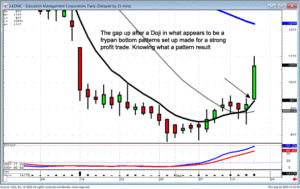
EDMC
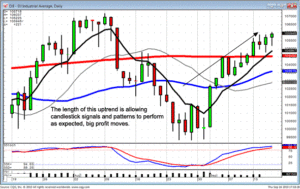
DOW
There has been good profits made in this last market move. Have all the recommendations made profits. Definitely not, but knowing how to apply candlestick analysis to your portfolio makes closing out the unprofitable trades quickly and anticipating where the next strong price moves may occur. For those of you that are fairly new to candlestick analysis, you will find there is a completely different perspective on how to make profits. The assumptions attached to candlestick analysis are not one of speculation, they are utilizing the information built into graphic chart formations that have demonstrated what the candlestick signals and patterns are representing.
If you have not had the opportunity to participate in the two day candlestick training course, please think about this seriously. When you see all the common sense aspects of candlestick analysis put into a logical order, you begin to have a completely different perspective on how to make profits in the markets. You will know when to be buying and you will know when to be selling. Steve Bigalow demonstrates the powerful implications that are revealed through the candlestick signals. He will teach you in a manner that allows you to immediately look for and take advantage of profitable trades.
Chat session tonight at 8 PM ET. Everybody is welcome.
Good Investing,
The Candlestick Forum Team
E-Learning Online Training Schedule
Options Training Course
October 16 & 17, 2010
Commodity Training
November 6 & 7, 2010
Boot Camp
November 20 & 21, 2010
Website special reflects current newsletter. If you are reading an archived newsletter you will be directed to the Current Website Special
Stock Market Terms – Saying It The Right Way
When preparing for an interview, a prospective employee will usually do some research on a company and its products. If the prospective employee has never worked in the particular field, he or she might try to learn some of the “buzzwords” related to the business. Knowing some of the terminology can help even the beginning trader successfully discuss investment philosophies as well. Below are some of the stock market terms that will help you when speaking with someone else in the business:
Basic terms
These stock market terms reflect common ideas and descriptions that are used every day. Such stock market terms portray types of people and general stock market basics.
- Ask – This is the lowest price that a seller will accept when selling a stock.
- Bear – This refers to an investor who believes the stock market or a particular stock is declining. This is the opposite of a Bull.
- Bid – This is the highest price that a buyer is willing to pay for a stock.
- Broker – A person that buys or sells stocks, bonds, commodities and such in exchange for a fee which is called a commission.
- Bull – An investor who believes the whole market or one individual stock is going to increase in price. This is the opposite of a Bear.
- Dow Jones Industrial Average – This is a compilation of the 30 most traded blue chip stocks. This list is the most widely used for analyzing stock market indexes.
- NASDAQ – This is a stock exchange consisting primarily of technology companies.
- Stock – This is the smallest measurable unit of ownership in a company. Shares fall into either the common or preferred categories; companies issue shares of stock in order to raise capital without borrowing money.
Investing terms
These words and phrases reflect stock market terms for various stock market strategies. These stock market terms are used to describe specific conditions or analysis.
- Blue Chip – This term describes a company with a history of strong earning, traditionally increasing dividends and an outstanding balance sheet. Blue Chip stocks include Exxon-Mobile, Coca-Cola and Wal-Mart.
- Book Value – This is the value of a company if assets and common stock equity are added together and all liabilities are subtracted. There is little correlation between the book value and the market value. Book value is used in such fundamental analysis measurements as Price to Book ratio.
- Dividend – This is the portion of a company’s profit that is given back to the investors. Such payments are made on either an annual or quarterly basis.
- Market Capitalization – A company’s market capitalization, also known as its market cap, is calculated by taking the number of outstanding shares of stock multiplied by the current price per share.
- P/E Ratio – This widely used analysis tool of Price to Earnings ratio measures now you pay for each dollar of corporate earnings. For example, if you have $30 stocks that report a profit of $2 per share, your P/E ratio is 15; $30 per share divided by $2 earnings per share equals 15. In this ratio the lower the P/E ratio, the better.
- Spread: This stock market term reflects the difference between the Ask and the Bid.
- Yield – This is the percentage of a dividend paid against the stock price. For example, if you receive a $3 dividend on a $30 per share stock, your yield is 10%.
Conclusion
It is much easier to discuss the stock market if you understand some of the basic stock market terms. There is a large variety of stock market terms and learning them will not only help in your conversations but also to better comprehend the tools available for technical analysis.
- « Previous Page
- 1
- …
- 11
- 12
- 13
- 14
- 15
- …
- 41
- Next Page »

